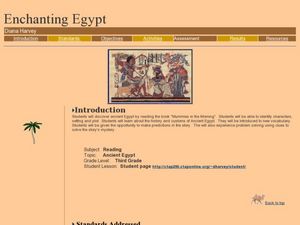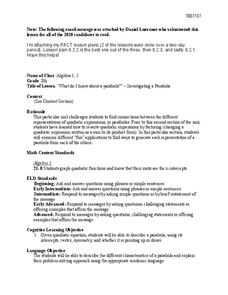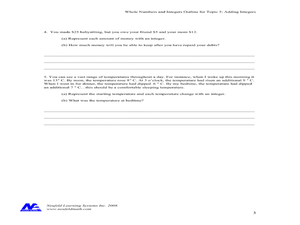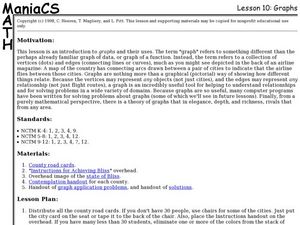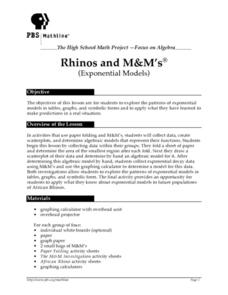Curated OER
Enchanting Egypt
After reading the Magic Tree House book Mummies in the Morning, learners talk about Ancient Egypt. They identify the plot, characters, setting, etc., explore vocabulary terms, and construct a pyramid. This will motivate your class to...
Curated OER
Mi Perro Perdido (My Lost Dog)
Students receive a map of the school and a set of directions in Spanish for each pair that lead them to a specific place on campus. They use the directions and maps to leads them to pieces of colored paper that have been hidden. Each...
Curated OER
Principles of Flight: Flying Paper Airplanes
Students investigate ways to enhance an object's flying ability. In this model construction lesson, students construct two paper airplanes, one of which is twice as big as the first. Students compare and contrast the two separate...
Curated OER
New York State English Language Arts Test" Listening Selection Grade 7
An article about Dr. Robert Metcalf's work to create solar cookers is the subject of an article used in 2010 on the New York State listening exam. Although no questions are included, the passage is ideal for such an exam and questions...
Curated OER
New York State Testing Program: English Language Arts Listening Test Selection Grade 7
Although labeled as a listening test, no questions accompany Jim Davis’ "Flight of Fancy," a short essay in which he describes how he came to be a cartoonist and the creator of Garfield. However, the article is interesting and crafting...
Curated OER
Ancient Egypt/Mummification/Preservation
Sixth graders identify characteristics of preserved artifact, distinguish between an example and non-example of a preserved artifact, and connect the definition of preserve to the Egyptian art of mummification.
Curated OER
Investigating Parabolas
Students identify properties of parabolas. In this algebra lesson, students factor quadratic equations and identify the properties of parabolas. They find the roots, vertex and intercepts of a parabola.
Curated OER
Investigating DNA
Students engage in a variety of activities designed to facilitate the understanding of DNA. Activities include preparing human chromosome spreads, separating a mixture of dyes using gel electrophoresis and extracting DNA from onion cells,
Curated OER
Scientific Notation
In this algebra worksheet, 9th graders rewrite exponential numbers using scientific notation and condense the equations and expand using the standard form. There are 6 word problems applying the use of scientific notations.
Curated OER
The Pentagon Papers
Students examine national security issues. In this Vietnam lesson, students research the background and controversy surrounding the Pentagon Papers. Students discuss press rights in light of maintaining national security.
Curated OER
Concept: Adding Integers
In this integers online interactive worksheet, students complete a chart on adding integers and rewrite 11 positive integer questions without the positive signs. Students solve 2 online integer word problems on the lines provided.
Curated OER
The Changing Me
Third graders study the human body. In this health lesson, 3rd graders discuss that everyone's body is growing, measure body parts using a tape measure, and color the body worksheet.
Curated OER
Lesson 10: Graphs
Students explore graph theory. In this geometry lesson, graphs are used to solve problems in a variety of domains. In this lesson the term graph refers to a collection of vertices and edges used to depict travel routes.
Curated OER
Math Words with Multiple Meanings
Learners of many ages use the Visual Thesaurus to help them understand the language of math. They work in groups to explore the multiple meanings of common math terms. Pupils come up with examples of the words in mathematical and other...
Curated OER
Higher (Priced) Education
Students explore the proposed Affordability in Higher Education Act. They synthesize their knowledge by acting as lobbyists representing different special interest groups with opposing perspectives on the proposed bill.
Curated OER
Rhinos and M&M's
Students analyze patterns of exponential models by collecting data in paper folding and M&M investigations. They use graphing calculators to create scatter plots that lead to equations for the exponential models. They then apply this...
Curated OER
Chilling Out
Students determine the breakdown of worldwide energy consumption by various sources. After reading an article, they examine recent research in the area of alternative energy sources. Using the internet, they research the forms of...
Curated OER
Biomolecules
Students perform an experiment in which they test foods for the presence of proteins, carbohydrates, and lipids. They identify the molecular structure of each type of biomolecule and then discuss how biomolecules relate to nutrition and...
Curated OER
Osmosis and the Cell Membrane-part 2
Young scholars participate in a review of diffusion and the basic properties of the cell membrane before exploring the process of osmosis in a lab activity. Using shell-less eggs that have soaked in various solutions, students make...
Curated OER
Wish Boxes
I love these are lesson ideas! Young artists practice the art of Calligraphy and Origami. They make gift boxes with good wishes. This plan includes an excellent component that shows exactly how to fold the paper in order to make the box,...
Curated OER
How To Use the Six Traits of Writing
Use these reference tools to plan and organize the Six Traits of Writing Program.
Curated OER
Student Safety Contract
With spaces for both your science pupils and their parents to sign, this laboratory safety contract is a must-have for your science classes. Twenty-one rules applying to protection and hazard prevention are listed. Discuss them with your...
Scholastic
Writing to a Historical Poet
Poetry is a very personal and introspective art form. Give your class the opportunity to understand how a poet's voice can speak to them on a personal level, and that every reader can respond to an author differently. After a poetic...
Curated OER
Myths, Folktales, & Fairy Tales
Introduce the concept of myths to your class. Using the link to "Myths Around the World," read a story aloud and have learners list characteristics of a myth. Readers then choose their own myths from the site and work in groups to answer...


